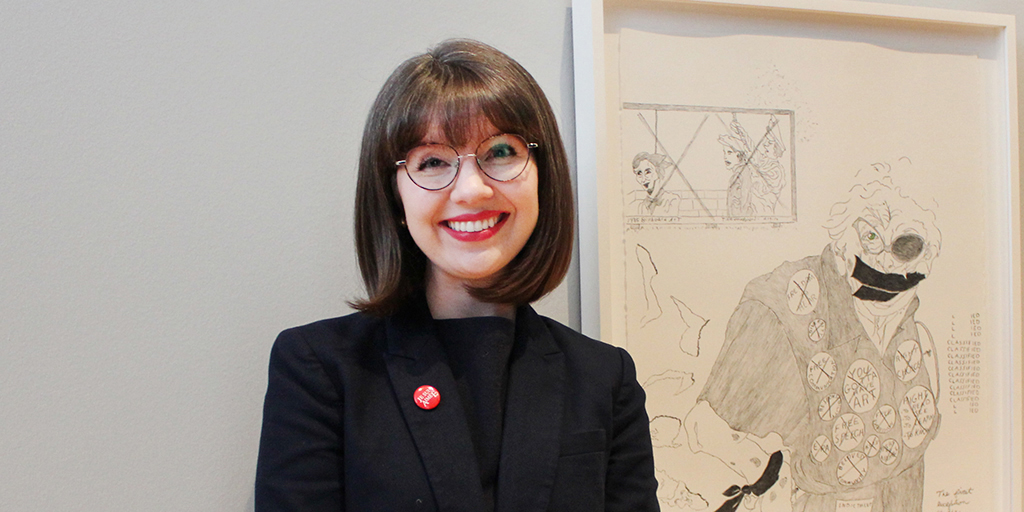Exhibition affirms ongoing relevance of Kansas artist 'Grandma' Layton

LAWRENCE – When Elizabeth “Grandma” Layton rocketed to art world fame — capped by a Smithsonian American Art Museum exhibition in the late 20th century — it was her unflinchingly honest yet beautiful portraits of old age that won her acclaim.
A new exhibition of her work reminds viewers of that but also of the more overtly political stances she took in her work.
Mary Frances Ivey, a doctoral candidate in the Kress Foundation Department of Art History at the University of Kansas, has curated an exhibition titled “Elizabeth Layton: Drawing as Discourse,” opening Jan. 25 and running through July 28 at the Nerman Museum of Contemporary Art at Johnson County Community College.
The show grew from the first chapter of Ivey’s forthcoming dissertation, titled “Picturing Age in the Work of Three Contemporary American Women Artists.”
Ivey said Layton, who was the former managing editor of the Wellsville Globe, had what is now known as bipolar disorder. She underwent more than a dozen electroshock treatments before discovering her artistic talent in a drawing class – her one and only bit of formal training – at Ottawa University.
Layton began drawing in 1977 at age 68 and continued almost until her death in 1993.
“Layton was very, very interested in representing mental illness to advocate for others suffering and to remove the stigma of both experiencing mental illness but also seeking mental health care,” Ivey said. “All of that is related to the fact that making her art ... she credited it with treating her mental illness — the fact that she could represent visually something that's basically indescribable and try to convey to people what it's like.”
Using and expanding upon the rudiments of her class in blind contour drawing, Layton drew self-portrait after self-portrait, often including her husband, Glenn, flowers and objects from their Wellsville home.
“She has a very visually distinct artistic style,” Ivey said. “You know it when you see it.”
The curator said Layton’s “interest in line is very closely connected to the way that she's interested in older people. She uses a kind of frazzled, frizzled, wobbly line that is so perfectly suited to representing the crinkled skin and knobby knees and gnarled joints and the amoeba-like liver spots on the skin. I see a kind of connection between the line quality that she likes and the people she likes to draw.”
Layton was also inspired, Ivey said, to “make work about the times in which she lived — current events — and, sadly, so many of the current events and social issues that she was most interested in still feel very timely and fresh and new.”
The show includes drawings and lithographs that touch on such topics as sexism, gay rights, fatphobia, police brutality, censorship, the Holocaust, the genocide perpetrated against Native Americans by European settler-colonialists and more.
Ivey said she gathered the 30 works in the show from Nerman Museum itself, as well as KU’s Spencer Museum of Art, the Nelson-Atkins Museum, the National Museum of Women in the Arts, the Wichita Museum of Art and the Marianna Kistler Beach Museum of Art at Kansas State University.
A few works also came from private collections, including that of former journalist Don Lambert, who helped to first popularize Layton’s works. Lambert, who lives in the Kansas City area, and Ivey will have a gallery conversation with a reception to follow March 28 at the Nerman.
“I would credit him as an adviser to the exhibition,” Ivey said. “We're lucky because we're living in the destination for Elizabeth Layton studies, if you will.”
Not only are the topics Layton addressed still relevant, but so is her status as a “naive” or “outsider” artist, Ivey said.
“We are increasingly interested in listening to so-called outsider voices — people who are not immediately embraced by the art world — and saying, ‘What can we learn here, not just from the content of the work, but also their approach to art making?’ There is an interest in inclusivity and a desire to see more variation in style that really benefits someone like Elizabeth Layton, who – as an older person, a rural Kansan and a minimally trained artist — is kind of on the edge.”